Distinguished Physics Alumni
Dr. Tracy Steinbach (2018)
Dr. Tracy Steinbach graduated from GVSU with a B.S. degree in physics in 2010. Later she earner her PhD in chemical physics from Indiana University, Bloomingdale in 2016. Her dissertation research focused on measuring the fusion cross-section of 16,18O + 12C using low intensity beams at energies near and below the Coulomb barrier. These experiments utilized direct measurement of the fusion residues – distinguished from incident beam particles on the basis of their energy and time-of-flight. A central aspect of my research was the design, construction, and characterization of a microchannel plate (MCP) detector. These MCP timing detectors overcame a major obstacle confronting the initial fusion studies conducted by the group. Improvements I implemented in the experimental setup allowed measurement of the fusion cross-section of 18O+12C down to ~ 2 mb, a full order of magnitude below previous direct measurements.
Dr. Paula "Paige" Kelley (2016)
Paige Kelley earned dual B.S. degrees in Physics and Mathematics from Grand Valley State University in 2009. During her time at GVSU, Paige gained a wealth of undergraduate research experience on topics ranging from semiconductor physics to surface science that inspired her to pursue a research career. Paige attended GVSU on a Presidential Scholarship and received the 2009 Glenn A. Niemeyer and Physics Department senior awards. Following a year of service in the AmeriCorps VISTA anti-poverty program, she accepted a Presidential Doctoral Fellowship at the University of South Florida and conducted her Ph.D. research on strongly correlated low-dimensional magnetic oxide systems. She earned her PhD in applied physics from University of South Florida in 2015.
She currently holds a joint postdoctoral research position at the University of Tennessee and Oak Ridge National Laboratory, participating in a Moore Foundation EPiQS initiative to study emergent phenomena in novel quantum materials. Paige has co-authored over 20 scientific journal articles and collaborated with scientists around the world, including time spent as a guest researcher at the NIST Center for Neutron Research and the Institute of Physics in Kosice, Slovakia. Her current research interests include the study of frustrated and non-centrosymmetric magnetism through a combination of novel single crystal growth and neutron scattering techniques.
Steven Gardner (2014)
Stephen received his B.S. degree in Physics from GVSU in 2009. During his time at Grand Valley, Stephen was a recipient of the GVSU Presidential Scholarship and Arend D. Lubbers Honors College Scholarship. He was a member of the Honors College and maintained standing on the Dean’s List throughout his undergraduate career. In addition, he was a member of the Society of Physics Students (SPS) and was inducted into Sigma Pi Sigma, the national SPS honors society. After graduation from Grand Valley, Stephen attended graduate school at Vanderbilt University in Nashville, TN, earning a M.S. degree in Therapeutic Medical Physics in 2011. After his time in Nashville, he accepted a position in the Medical Physics Residency Program at Thomas Jefferson University Hospital in Philadelphia, PA. Stephen completed the residency program in the summer of 2013, and is now employed as a Senior Associate Medical Physicist at Henry Ford Health System in Detroit, MI. Though his appointment at HFHS is primarily clinical, Stephen also performs research; currently, his main interests are related to the integration and evaluation of advanced imaging techniques in radiotherapy. In addition, Stephen has taken on a mentorship role in the Medical Physics Residency Program at Henry Ford Health System.
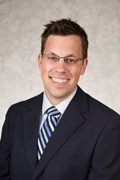
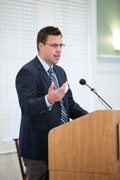
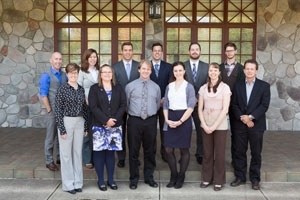
Dr. Rhonda (Graves) Vickery (2012)
Dr. Rhonda Vickery is a prime example of the versatility of a physics degree and of lifelong learning. After earning her B.S. in physics from GVSU in 1984, Rhonda went on to earn her B.S.E. in Computer Engineering from the University of Michigan, her M.S. in Computer and Information Science from the University of South Alabama, and her Ph.D. in Computational Engineering from Mississippi State University. She has worked on computer control of aircraft, paper manufacturing and the rendering of sedimentation models in a virtual reality environment. She is currently employed at Dynamics Research Corporation as the site lead for the DoD High Performance Computing Modernization Program (HPCMP) in support of the User Productivity Enhancement, Technology Transfer and Training (PETTT) Program. Her team works on the development of scientific visualization, data mining and knowledge discovery, image analysis, problem solving methods ad computational techniques for intelligent extraction of useful information from data. When she's not working, she enjoys spending time with her family in a variety of outdoor recreational activities, including cycling, hiking and camping.
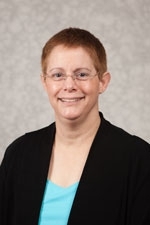
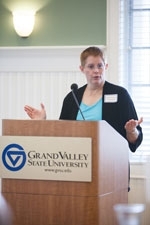
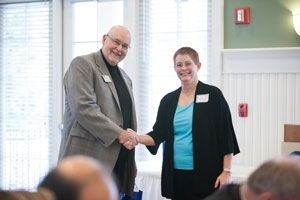
Dr. Kenneth Bader (2010)
While some find their eventual careers relate in an obtuse way to their undergraduate research experiences, my work has never strayed very far from the research I did within the Physics Department at Grand Valley State University. In the summer of 2004, I obtained funding through the Michigan Space Grant Consortium to study the impact acoustic cavitation on bone fractures. Under the guidance of Dr. Karen Gipson, I learned that acoustic cavitation was the action of bubble oscillations on the surrounding medium. I found sufficient interest in the topic to pursue graduate degrees in physics at the University of Mississippi. These studies revolved around a project intending to generate a thermonuclear reaction within a bubble undergoing an inertially-driven collapse. There was some precedent for the potential to generate a fusion reaction, as light emissions generated via thermal Bremsstrahlung as the bubble contents form a warm, dense plasma during the final stage of collapse. My work elucidated the influence of the static over-pressure on the strength of the bubble collapse in a resonant system. These results uncovered that the bubble collapse strength, indicated by light emissions and shock emission amplitude, were dependent on the energy stored in the system. That is, there was conservation of energy, a premise that should be of surprise to no physics student.
After my graduate studies, I was a postdoctoral fellow at the University of Cincinnati under the tutelage of Dr. Christy Holland. Our translation studies were centered on inducing sustained, subharmoic bubble activity to enhance the efficacy of fibrinolytic stroke treatment. Stroke is the fourth highest cause of death in the United States, and only 1.5% of patients receive thrombolytic drugs due to strict exclusion criteria. The use of oscillating bubbles as micropumps increases thrombolytic efficacy, thereby increasing the pool of patients that can receive therapy. While in Cincinnati, I also become interested in histotripsy, a form of therapeutic ultrasound that liquefies tissue at depth via rapid bubble expansion. Histotripsy can be utilized as a transcutaneous scalpel, lysing cells and breaking up the extracellular matrix without the need for an invasive surgical procedure.
I have continued the theme of cavitation in my research as an Assistant Professor in the Department of Radiology at the University of Chicago. My laboratory, the Biomedical Acoustics Development and Engineering Research Laboratory (or BADER Lab), is focused on the development of multimodal image guidance methods for histotripsy. By combining diagnostic ultrasound imaging to assess cavitation activity with MR imaging to detect changes in tissue structure, we hope to develop next generation therapies to treat chronic deep vein thrombosis and localized prostate cancer.
Cavitation has been THE central theme of my scientific and professional career, a topic that I would not have pursued without the support and guidance of the Physics Department at Grand Valley State University. Beyond cavitation, my time at Grand Valley taught me the importance of finding ways to solve problems. I learned physics is a great guise through which to learn problem solving, the critical skill necessary for long-term success regardless of one’s career path.
James Vander Weide (2008)
James Vander Weide earned his B.S. in Mathematics & B.S. in Physics from GVSU in 1996.
Since his sophomore year in high school Jim knew he wanted to be a teacher. To pursue that career he joined the Unites States Air Force to help with college costs. He served four years in the USAF and an additional six years in the Air National Guard. In the Fall of 1989 he began his education at GVSU as a mathematics major, but after taking a few physics courses he changed to a double major in mathematics and physics.
After teaching for a year on the east side of the state, Jim began teaching physics in the Fall of 1997 at Rockford High School. In the Summer of 2004, Jim received a call from Hudsonville High School asking him to revitalize their physics program, and to date he has helped double the numbers of regular and AP physics sections offered there. Jim attributes his success as a teacher to the education received at GVSU, the methods of instruction learned through research done on student learning, and the knowledge obtained about using inquiry-based learning as opposed to lecturing.
In addition, Jim has participated in grading the AP College Board Physics tests for the last five years and has been an adjunct physics professor at GVSU for the last six years.
Christopher Brooks (2007)
Chris Brooks graduated from GVSU with a double major in physics and mathematics in 2001. He was on the Deans list for his entire undergraduate career and won senior awards in both departments. Following his graduation from GVSU, Chris went on to pursue graduate studies in shock-wave physics at Washington State University. He received his M.S. in physics in 2004; his thesis was entitled "Exploration of Several Aspects Pertaining to Multiply Shocked Water." He also received certification in Optoelectronics. Chris has been employed as a development engineer at Aculight Corporation since 2004, where he has done extensive research on fiber amplifiers and lasers. He has published numerous papers on that work, received one patent, and has several patents pending. He currently lives in Seattle.
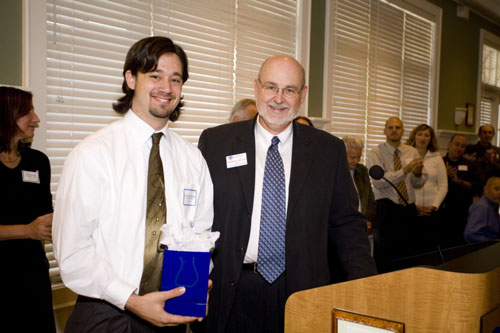
Chris Brooks with Dr. Frederick J. Antczak , Dean of CLAS
Paul Stoner (2005)
Paul Stoner earned his B.S. degree in physics from GVSU in 1971 and M.S. in physics from Murray State University.
To date, Paul Stoner has over thirty years of experience in health physics and radioactive material management, including work in four nuclear power plants. For twelve years, Mr. Stoner was on a utility company's corporate health physics staff and for six additional years was an analytical engineer for a large architectural/engineering company. Currently Mr. Stoner lives in Irvine, California, and is on the health physics staff of a radiation dosimetry processing company.
Susan M. Morford (2003)
Susan Morford graduated twice from GVSU, initially with a BS in Physics in 1970 and again in 1992 with a BSE in Engineering with an Electrical Engineering emphasis. She also earned an MA in Physics from Western Michigan University in 1973. From 1976 through 1990, Susan taught as an adjunct faculty in Grand Valley's Physics Department. Following her engineering degree completion in 1992, Susan has been employed by the Howmet Research Corporation, where she has served as Project Engineer for four major initiatives. It's interesting to note that Susan's association with the Howmet Research Corporation actually began while she was an engineering student on her co-op assignment; her work as a student developed into a full-time position as a project engineer.
Amy Stone (2001)
Amy Stone earner her B.S. degree in physics in 1997. As Ms. Stone was completing her degree from Grand Valley, the faculty recognized her as the outstanding physics graduate for 1997. Since graduation Ms. Stone has been a high school teacher, first at Holland High School where she taught mathematics, and now at Forest Hills Central High School where she teaches physics and coaches the school's Science Olympiad team. She has a M. Ed. degree, with an emphasis in physics from Grand Valley State University. The Physics Department faculty are pleased to use this occasion to thank and honor Ms. Stone, as she is a model of what a good high school physics teacher should be.

